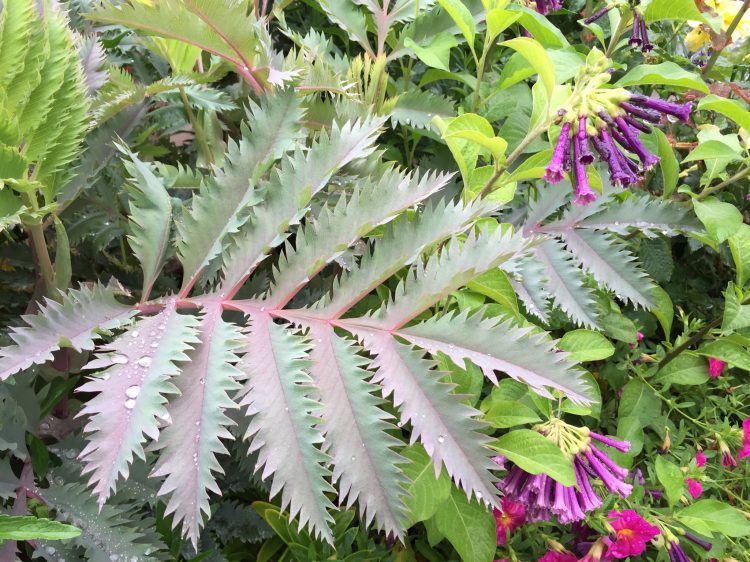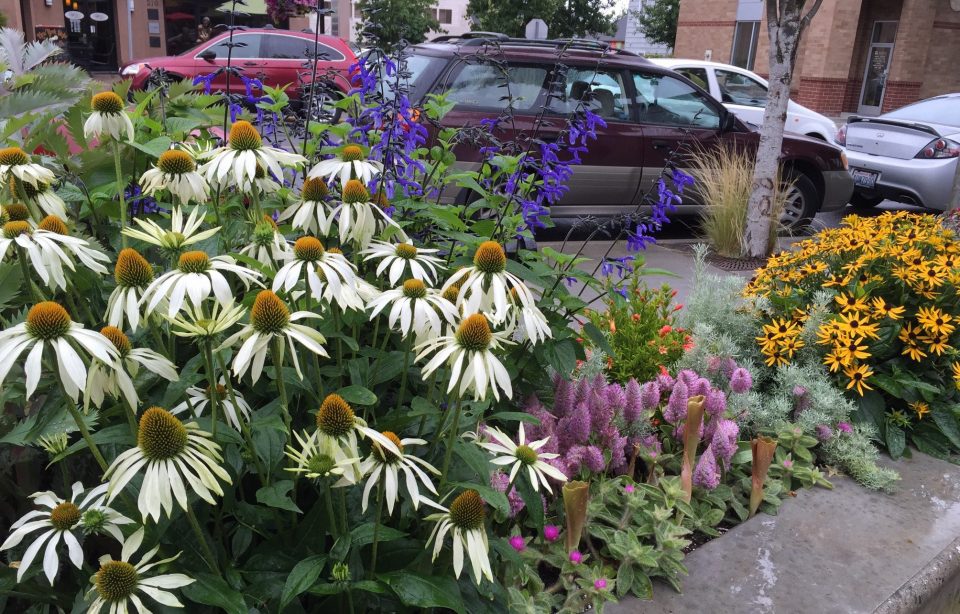Salvia ‘Black & Bloom’ dances above the cheerful faces of Echinacea and Rudebeckia. Gomphrena ‘Pink Zazzle, Ptilotis ‘Joey’, Punica ‘Nana’ and Artemsia ‘Sea Foam’ (from L-R) provide a lower layer of texture.
The Purple Haze Bed
Of all the splendors in this year’s test garden, we’re most excited about some of the plants we’ve selected for this bed. We lost some stellar plants here from last year (including a variegated Echium candicans ‘Star of Madeira’ and three Dodonaea viscosa ‘Purpurea’ (the Dodos made it through winter, just didn’t survive our experiments with pruning!), which left some big holes for new trials.

Melianthus ‘Purple Haze’ and Iochroma ‘Royal Queen’
The main bed contains two Melianthus major ‘Purple Haze’ (pictured at right). We fell head-over-heels for this newer purple cultivar of Honey Bush when we spotted it at Suncrest Nurseries in May. More compact in habit, this variety should behave better in this tight setting over the straight species. Melianthus bloom in big burgundy clusters—a show we should see this year. Nearby are two Punica granatum ‘Nana,’ or dwarf Pomegranates. Yes, these are truly Pomegranates! This is another Petula favorite, covered with bright orange waxy blooms that will give way to small fruits. This plant has proven itself to be hardy in the PNW (even down to about 10 degrees). These Punica will stay dwarf and compact, and will likely defoliate this winter, though we expect them to return and thrive here in Edmonds.
A couple of great, unusual perennials are also located here: Kniphofia caulescens and Artemisia versicolor ‘Sea Foam.’ The Kniphofia (aka Lesotho Red Hot Poker) is noteworthy for its spiky blue-green foliage from thick agave-like crowns. This South African species will bloom in mid to late summer and will feature tall spikes in more muted gradient than other pokers. Amidst the bed, we’ve planted Artemisia ‘Sea Foam,’ another plant we fell in love with at Suncrest. Its texture is unlike other Artemisia: fine, wispy, and indeed, frothy. We love this plant as a foil for the green blades and vibrant blooms that rise from the ‘Sea Foam.’
The newly introduced Salvia ‘Back & Bloom’ is located here. We are trialing this against the much-loved garden standard, Salvia guaranitica ‘Black & Blue’ (read more about this at the Night Sky bed). We’ve added the Australia plant, Ptiltous ‘Joey,’ to the garden again this year (we didn’t feel that this Pink Mulla-Mulla got its due last year!), along with the spectacular blooming Calibrachoa-Petunia cross, x Petchoa ‘SuperCal Neon Rose.’ Also spilling over the walls is Crassula capitella ‘Campfire,’ which will develop into a bright red color worthy of its name.
Another annual/tender perennial here is Leonotis leonurus. You might know this plant as Lion’s Tail (or, as its more accurate translation, Lion’s Ear). It’s beginning to bud, and we think it’ll be a great surprise for visitors in late summer, when it skyrockets, then shoots out tongues of furry bright orange from whorl after whorl on each stem. Native to South Africa, Leonotis is a little-known plant around here, but a total gem worth coveting.
If you look at the boxes here, you’ll see that both of our prized Phylica arborea (aka Island Cape Myrtle) remain from 2015. Another soft “touch me” plant, the windswept-looking Phylica are perfect for seaside Edmonds. The Phylica are accompanied by another dwarf variety of Kangaroo Paw, Anigozanthos ‘Flame.’ We are trialing this variety (along with ‘Deep Orange’ in the Night Sky boxes) to see its longevity and capacity for rebloom. We’ve also replanted Gomphrena ‘Pink Zazzle’ this year. This plant was one of the most commented on of the annuals in last year’s garden and we were highly impressed with its lasting bloom (and rebloom!), along with its adaptability in a mixed planting.
If you’ve spotted the fern in the boxes, good eye! You may think we’re crazy, but we’re big fans of Cheilanthes lanosa (aka Hairy Lip Fern), a sun-loving rock garden fern native to the eastern US. We love its fuzzy texture and silver-grey fronds. Along with its good looks, it should make an excellent companion for the other drought-tolerant plants like the Phylica, Anigozanthos, and Gomphrena in these boxes.
Sedum sieboldii rounds out the mix. Though it’s not new on the scene, we feel that it’s a spectacular, perennial Sedum underused in our area. It will act as a spiller in these boxes, and put on a show in fall when it blooms a vivid bright magenta.
back to the Petula Test Garden
